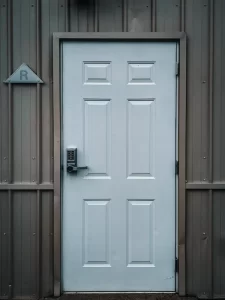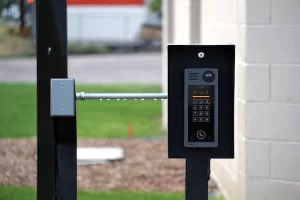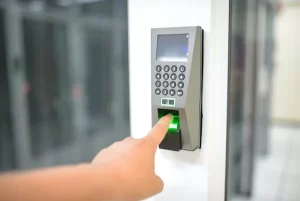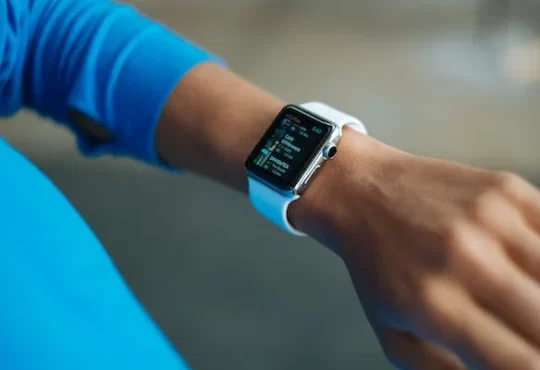
Smart Lock closed the door of the old door locks. Locks have transitioned from the traditional to the digital ones, keeping homes and other properties safe. With the integration of technologies, door locks have risen to their standard, along with their various features and specifications. It has become significantly beneficial for aesthetic use and safety purposes. In this article, let us dive into the world of top smart locks in 2024.
What is a Smart Lock?
A smart lock is an electronic mechanism designed for doors that offers remote activation through a smartphone app or virtual assistant. These locks can function with traditional keys, supporting keyless entry through numeric codes. Typically, locking the door requires pressing a single button, and some models offer automatic relocking features. Users can assign additional codes to family members and friends for access.
Smart locks provide a convenient and secure method to manage access to the properties you oversee, offering users a streamlined way to gain entry. Smart door locks offer enhanced flexibility in lock management, providing you and authorized individuals greater control and convenience over locking and unlocking operations.
Smart locks offer significant advantages to property managers, business owners, and venue operators, particularly when paired with a comprehensive smart access control system. This integration allows for precise control over access permissions and schedules, resulting in substantial time, resources, and cost savings.
The core function of a smart lock remains similar to that of a traditional lock, enabling the locking and unlocking of a door. However, what sets it apart is its integration of “smart” features, allowing remote control via a smartphone or through various smart technologies and integrated systems.
What are the differences between a smart lock and a traditional lock?
Several distinctions exist between a smart door lock and a traditional lock. Here are five key differences:
- Smart locks accommodate both physical and digital keys.
- Smart locks are controllable via dedicated mobile apps or a keypad interface.
- Smart locks offer remote functionality, allowing digital keys to be used from a distance.
- Smart locks seamlessly integrate into broader access control systems, enhancing user experience.
- Smart locks excel in managing properties remotely, reducing the need for constant on-site presence.
Are there different types of smart locks?
There are two different types of smart locks: adapted smart locks and native smart locks.
Adapted Smart Locks
Adapting existing door locks to smart technology is viable, even for electronic locks like maglocks that weren’t initially designed with smart capabilities. By integrating them into a smart system, they gain smart functionality.

Flexibility
- This approach offers tremendous flexibility, allowing users to choose from various electronic hardware options for access control. Customers can select the most suitable solution based on security needs, usage scenarios, and budgetary constraints.
Minimal Disruption
- Adapting existing locks to smart technology involves minimal disruption and damage to the door and frame since it builds upon the existing lock.
Integration
- Adapted smart locks seamlessly integrate with your current locks and access systems, ensuring compatibility and ease of operation across your security infrastructure.
Adapted smart door locks seamlessly blend with your current locks, maintaining the same appearance while integrating smart technology for enhanced functionality.
Native Smart Door Locks
Native smart door locks are purpose-built for electronic control, often through smartphone apps or electronic interfaces like keypads or keycodes.
Self-Contained Systems
- These locks are self-contained and independent of more extensive networks or platforms.
Battery-Powered Operation
- Many native smart locks run on batteries, simplifying installation but requiring periodic battery replacement, which can be inconvenient if the property is not easily accessible.
Installation Challenges
- Installing a native smart lock involves replacing existing locks, which may necessitate door and frame repairs.
Platform Dependency
- These locks are tethered to their proprietary platforms, limiting versatility and mandating the use of the lock operator’s app.
Bluetooth Connectivity
- Bluetooth is a standard technology used in native smart locks, limiting remote access capabilities and reducing the functionality of these systems.
Limited Security Options
- As standalone units with single-point locking mechanisms, native smart locks may not offer customizable high-security options for individual users.
Native smart locks are designed to replace existing access hardware, offering electronic control and modern convenience.
What are the top smart locks?
Opening the door depends on the variety of your chosen smart door lock.
-
PIN Smart Locks:
The most common methods include using a PIN (personal identification number) directly on the lock or remotely via your smartphone. You can unlock and lock doors with a simple touch or voice commands.
A smart lock PIN typically consists of four or five digits. You tap your PIN on the smart lock’s small touchscreen to unlock a door. You can use the same code through a mobile app to lock and open the door remotely while away from home. The top smart locks come with mobile apps and are compatible with apps from popular home security companies like SimpliSafe, Vivint, Frontpoint, and ADT.
As the account owner, you can provide unique PINs to each family member, nanny, babysitter, or dog walker. For added security, the best smart locks allow you to set schedules for specific PINs, and of course, you can deactivate a PIN at any time. You can monitor PIN usage through a mobile app and receive text notifications about the activity.
Smart locks limit the number of PINs you can create; you might have around a dozen slots available for temporary and permanent codes. Conversely, locks explicitly designed for the hospitality industry offer the flexibility to set an unlimited number of temporary or permanent codes. With smart lock mobile apps, sharing digital keys via text or email is straightforward.

-
Touch & Voice Control Smart Locks:
In addition to PINs, or as an alternative, top-tier smart locks offer touch-responsive functionality: A simple tap on the lock disengages the deadbolt. This feature operates seamlessly when you carry a keyfob connected to the system. The keyfob works near the touch and voice control smart lock, eliminating the need to remove it from your wallet or bag physically. This setup proves particularly handy when you arrive home laden with groceries or wrangling children. The same smart locks allow for quick relocking with a simple tap gesture.
Amazon Alexa and other virtual personal assistants lend a hand for added convenience. The finest smart locks promptly respond to inquiries like “Hey Siri, is my front door unlocked?” and directives such as “Alexa, lock the front door.” While some devices enable unlocking via voice command, it’s important to note that this method requires vocalizing your PIN. Hence, it’s advisable to avoid keeping a PIN active if there’s a risk of it being overheard. As previously mentioned, you can change the PIN anytime for added security.
Now, we’re top picks for the best smart lock overall! The Nest x Yale Smart Lock allows you to assign PINs with two distinct access levels. Users with Family status can create PINs, monitor account activity, and invite other users. Conversely, individuals without Family status receive PINs designated for Home Entry Only.
-
Bluetooth Smart Locks:
Smart lock apps for native smart door locks typically function similarly, all managed by the smart lock manufacturer. Generally, digital keys are shared with users. To unlock a specific door, users select the key within the app and use it to unlock the door. Many of these apps utilize Bluetooth technology to connect to the smart lock.
However, Bluetooth smart locks are constrained by the range of Bluetooth signals. Users must be near the lock they wish to control, limiting the flexibility and convenience for administrators and users alike.
Given these limitations, Bluetooth smart locks may not be suitable solutions for Airbnb hosts, property managers overseeing multiple properties, remotely managed properties, or locations requiring emergency access capabilities.
Bluetooth smart locks lack effective remote access capabilities since they cannot unlock the door from anywhere in the world.
The limitation arises because your phone, which serves as the unlocking device for the Bluetooth smart lock, must be within Bluetooth range for the smart door lock to function.
-
Internet-Connected Smart Locks:
In contrast to Bluetooth smart locks, internet-connected smart locks utilize 4G or Wi-Fi connections to access the internet.
Internet-connected smart lock solutions eliminate the restrictions of Bluetooth, allowing users to control the smart door lock from anywhere with an Internet connection. As a result, they are ideal for managing properties remotely or in situations where frequent travel is impractical.
The structure of associated smart lock apps is similar to other smart lock apps, providing users with a list of keys assigned by the administrator.
Smart locks equipped with Wi-Fi or 4G connectivity offer remote access functionality. Opting for a smart lock with Wi-Fi or 4G connectivity enables you to unlock your door remotely from anywhere worldwide, provided you have an internet connection.
This solution proves beneficial in scenarios where visitors, contractors, guests, staff, or emergency services need access to the premises but have yet to be assigned a digital key, and an administrator is not near the property.
Smart locks can function seamlessly with Wi-Fi, 4G, or Bluetooth, ensuring a suitable solution regardless of your preferred connection method.
-
Digital-Keyed Smart Locks
Smart locks necessitate the possession of a digital key, which grants access permissions. Typically, the digital key is securely stored in a smartphone app, a keycard, or a keycode.
In 2024, the top smart locks offer keyless entry through various methods. These include PIN touchscreens, simple taps, voice commands, and mobile apps. Additionally, some smart locks retain the option for traditional house keys as a backup.
-
Physical-Keyed Smart Locks
Smart door locks with physical keys offer a manual override feature, which is beneficial in case of smart lock malfunctions, making the physical key option quite useful.
With adapted smart door locks, your existing lock is retained and enhanced with smart capabilities. Consequently, you can continue using your current physical key to lock and unlock the door, eliminating the need for additional key cutting.
While not all, some native intelligent door locks also allow the use of a physical key in conjunction with digital entry systems.
Conclusion:
Therefore, upgrade your properties using these smart locks for an easy, fast, and safe experience, locking you and your family away from dangers. Live wise, lock smarter.




